Home / Five Key Factors That Influence Acidity
Acid Base Reactions
Five Key Factors That Influence Acidity
Last updated: February 12th, 2025 |
Five Key Factors That Affect Acidity
Today we’ll talk about what’s behind the trends in acidity for different molecules and discuss the most important factors that determine these values.
I’ve written in schoolmarmish tones before about how pKa is one of the most important measures you can learn in organic chemistry, and not knowing some basic pKa values before an exam is a lot like walking up to a poker table without knowing the values of the hands: you’re going to lose your shirt. (See article: Know Your pKas)
Let’s quickly review the basics of acidity and basicity. Here’s the condensed version:
- Bronsted acids are proton donors, Lewis acids are electron pair acceptors. Converse: Brønsted base = proton acceptor, Lewis base = electron pair donor.
- A conjugate base is what you obtain when you remove a proton (H+) from a compound. For instance, HO– is the conjugate base of water. O2- is the conjugate base of HO–. Conversely, conjugate acids are what you obtain when you add a proton to a compound. The conjugate acid of water is H3O+.
- Quick quiz: is pH 1 acidic or basic? pKa is similar to pH in that low (and even negative values) denote strong acids. That’s because pKa is based on the equilibrium:

- According to this, anything which stabilizes the conjugate base will increase the acidity. Therefore pKa is also a measure of how stable the conjugate base is. Put another way, strong acids have weak conjugate bases, and vice versa.
With that out of the way, let’s get started.
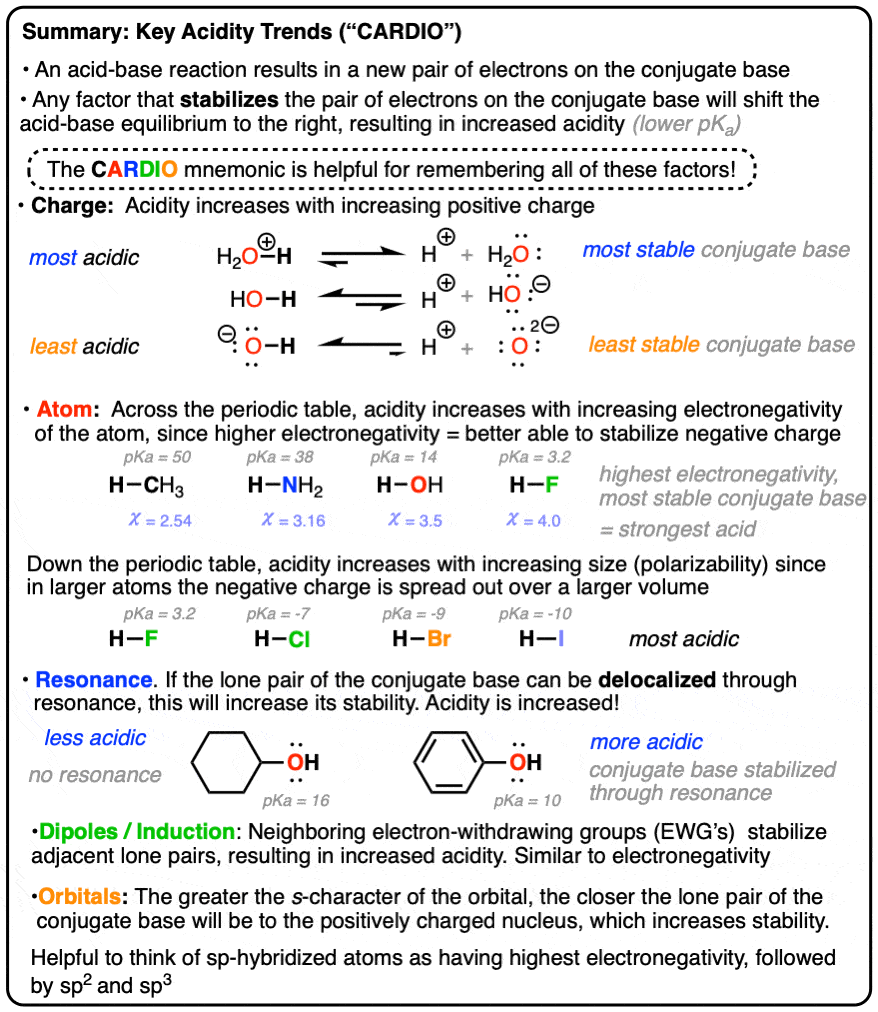
Table of Contents
- Factor #1 – Charge.
- Factor #2 – The Role of the Atom
- Factor #3 – Resonance
- Factor #4 – Inductive effects
- Factor #5 – Orbitals
- Quiz Yourself!
- Notes
1. Factor #1 – Charge.
Removal of a proton, H+ , decreases the formal charge on an atom or molecule by one unit. This is, of course, easiest to do when an atom bears a charge of +1 in the first place, and becomes progressively more difficult as the overall charge becomes negative. The acidity trends reflect this:
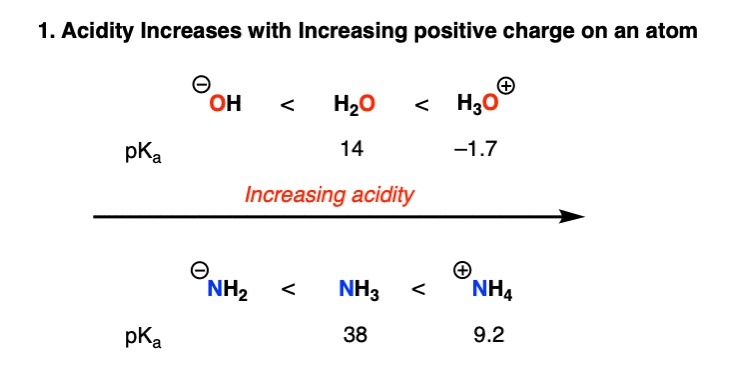
Note that once a conjugate base (B-) is negative, a second deprotonation will make the dianion (B 2-). While far from impossible, forming the dianion can be difficult due to the buildup of negative charge and the corresponding electronic repulsions that result.
2. Factor #2 – The Role of the Atom
This point causes a lot of confusion due to the presence of two seemingly conflicting trends.
Here’s the first point: acidity increases as we go across a row in the periodic table. This makes sense, right? It makes sense that HF is more electronegative than H2O, NH3, and CH4 due to the greater electronegativity of fluorine versus oxygen, nitrogen, and carbon. A fluorine bearing a negative charge is a happy fluorine.
But here’s the seemingly strange thing. HF itself is not a “strong” acid, at least not in the sense that it ionizes completely in water. HF is a weaker acid than HCl, HBr, and HI. What’s going on here?
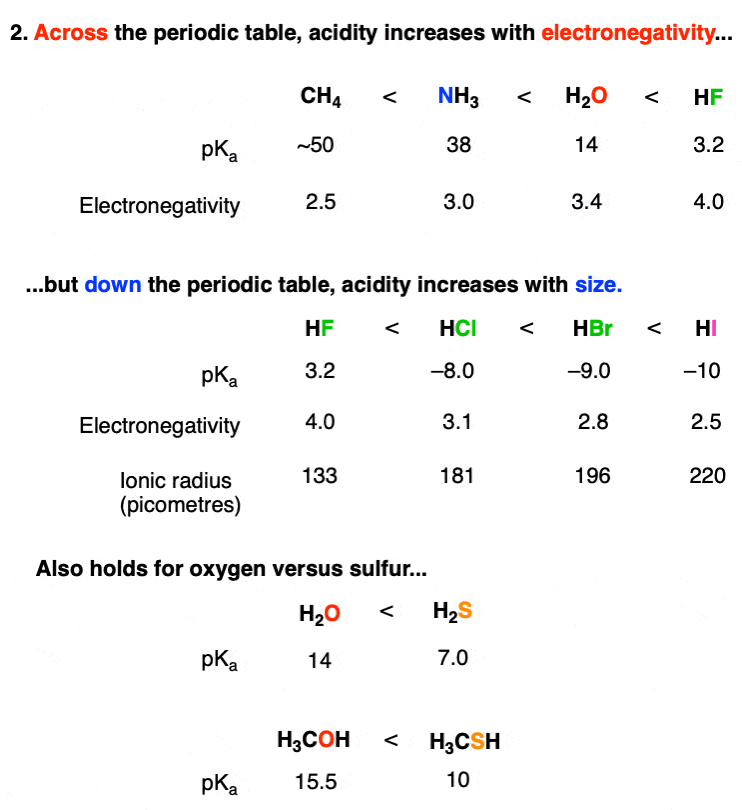
You could make two arguments for why this is. The first reason has to do with the shorter (and stronger) H-F bond as compared to the larger hydrogen halides.
The second has to do with the stability of the conjugate base. The fluoride anion, F(–) is a tiny and vicious little beast, with the smallest ionic radius of any other ion bearing a single negative charge. Its charge is therefore spread over a smaller volume than those of the larger halides, which is energetically unfavorable: for one thing, F(–) begs for solvation, which will lead to a lower entropy term in the ΔG.
Note that this trend also holds for H2O and H2S, with H2S being about 10 million times more acidic.
3. Factor #3 – Resonance
A huge stabilizing factor for a conjugate base is if the negative charge can be delocalized through resonance. The classic examples are with phenol (C6H5OH) which is about a million times more acidic than water, and with acetic acid (pKa of ~4).
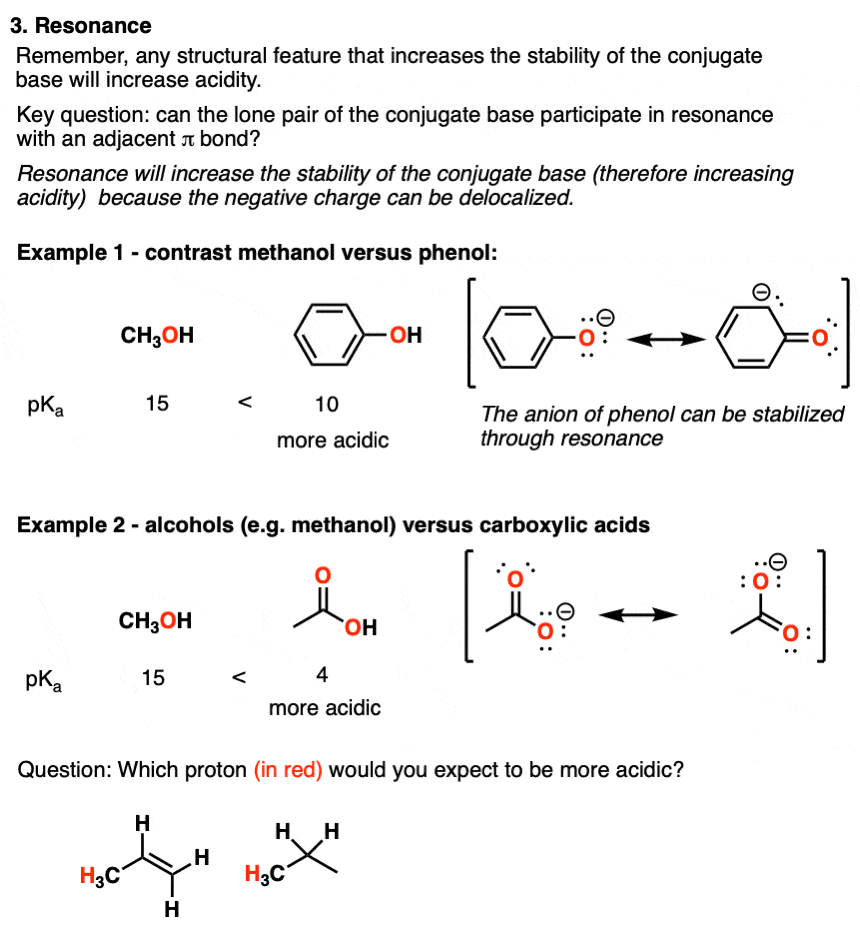
Watch out though – it isn’t enough for a π system to simply be adjacent to a proton – the electrons of the conjugate base have to be in an orbital which allows for effective overlap.
4. Factor #4 – Inductive effects
Electronegative atoms can draw negative charge toward themselves, which can lead to considerable stabilization of conjugate bases. Check out these examples:
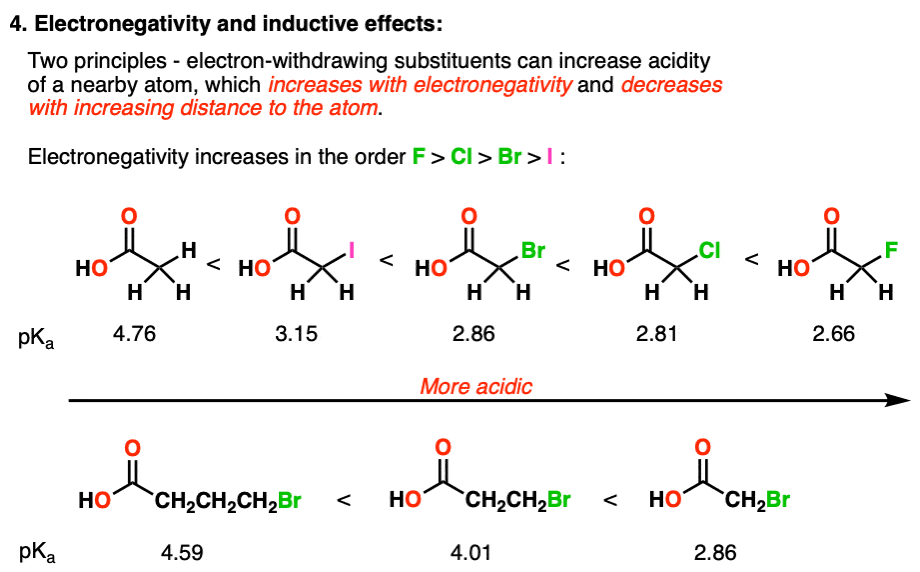
Predictably, this effect is going to be related to two major factors: 1) the electronegativity of the element (the more electronegative, the more acidic) and the distance between the electronegative element and the negative charge.
5. Factor #5 – Orbitals
Again, the acidity relates nicely to the stability of the conjugate base. And the stability of the conjugate base depends on how well it can accomodate its newfound pair of electrons. In an effect akin to electronegativity, the more s character in the orbital, the closer the electrons will be to the nucleus, and the lower in energy (= stable! ) they will be.
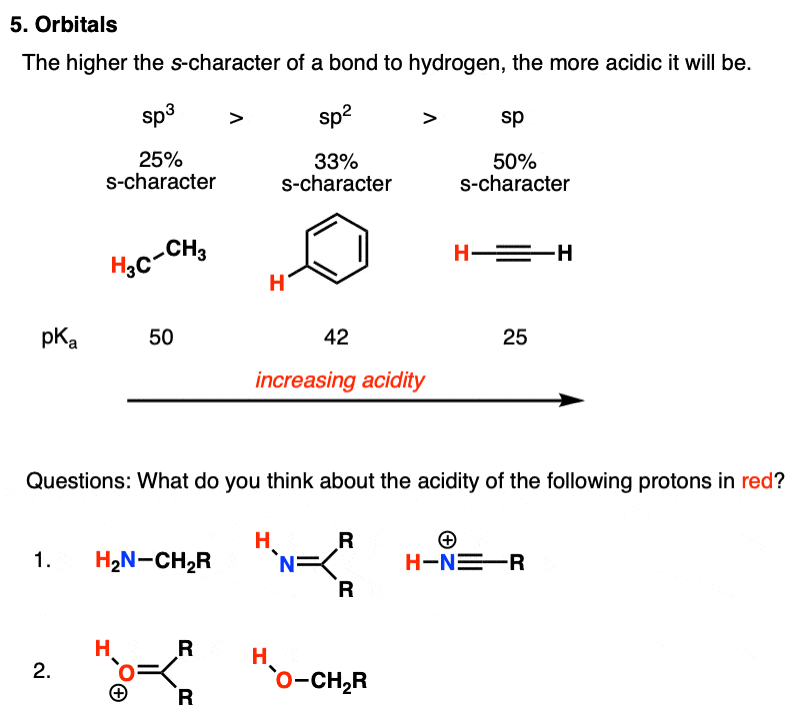
Look at the difference between the pKa of acetylene and alkanes: 25! That’s 10 to the power of 25, as in, “100 times bigger than Avogadro’s number”.
Just to give you an idea of scale. That’s the amazing thing about chemistry – the sheer range in the power of different phenomena is awe-inspiring. (See article: pKa Values Span 60 Orders Of Magnitude)
There’s actually a mnemonic I’ve found that can help you remember these effects. This is credited to Dr. Christine Pruis, Senior Lecturer at Arizona State University Tempe.
Charge
Atom
Resonance
Dipole Induction
Orbitals
= CARDIO.
Tread carefully with mnemonics, but there you go.
Quiz Yourself!

Become a MOC member to see the clickable quiz with answers on the back.
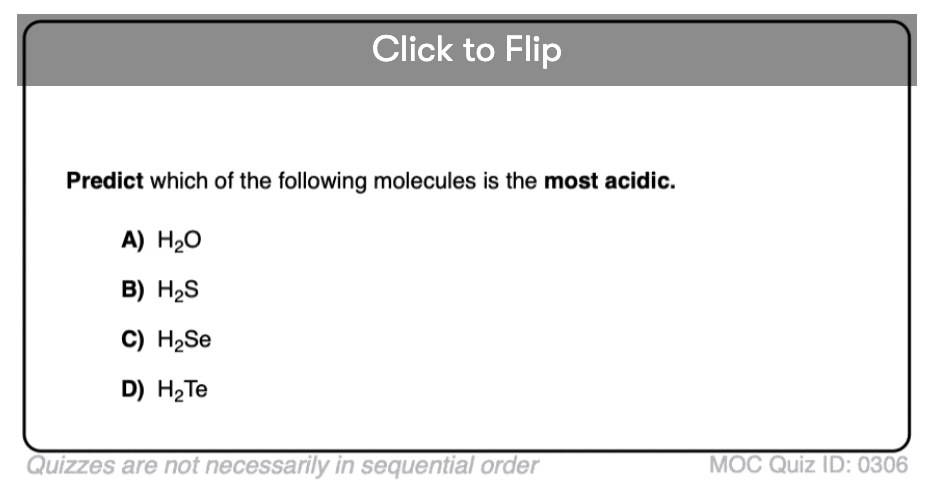
Become a MOC member to see the clickable quiz with answers on the back.
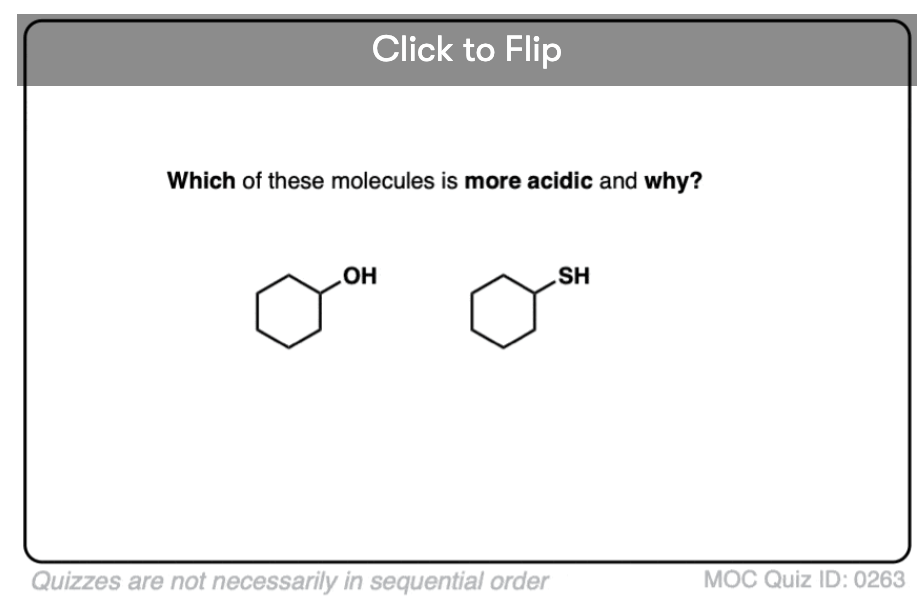
Become a MOC member to see the clickable quiz with answers on the back.

Become a MOC member to see the clickable quiz with answers on the back.
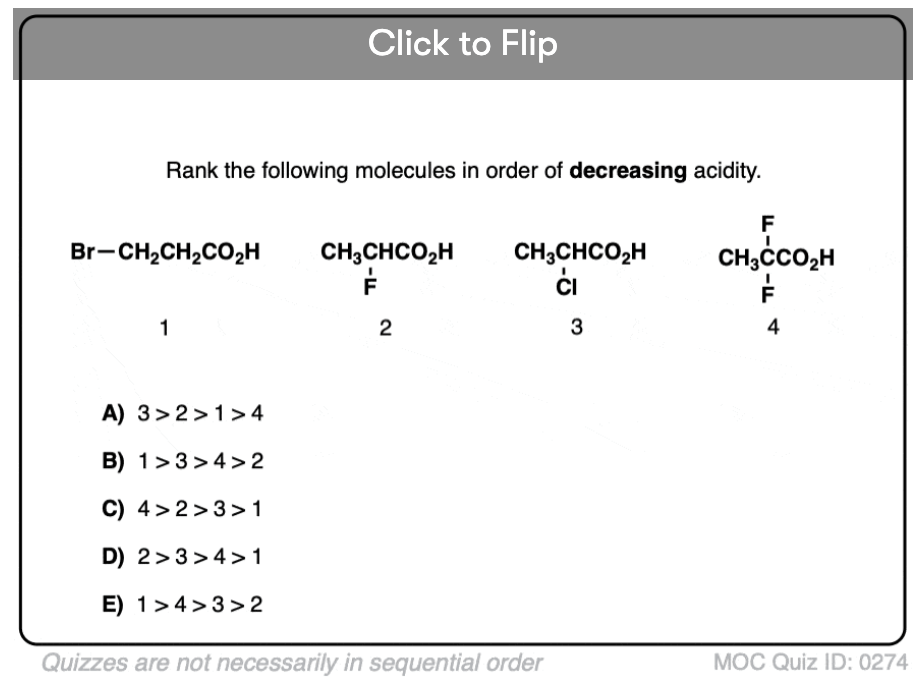
Become a MOC member to see the clickable quiz with answers on the back.
Notes
00 General Chemistry Review
01 Bonding, Structure, and Resonance
- How Do We Know Methane (CH4) Is Tetrahedral?
- Hybrid Orbitals and Hybridization
- How To Determine Hybridization: A Shortcut
- Orbital Hybridization And Bond Strengths
- Sigma bonds come in six varieties: Pi bonds come in one
- Dipole Moments and Dipoles
- A Key Skill: How to Calculate Formal Charge
- The Four Intermolecular Forces and How They Affect Boiling Points
- 3 Trends That Affect Boiling Points
- How To Use Electronegativity To Determine Electron Density (and why NOT to trust formal charge)
- Introduction to Resonance
- How To Use Curved Arrows To Interchange Resonance Forms
- Evaluating Resonance Forms (1) - The Rule of Least Charges
- How To Find The Best Resonance Structure By Applying Electronegativity
- Evaluating Resonance Structures With Negative Charges
- Evaluating Resonance Structures With Positive Charge
- Exploring Resonance: Pi-Donation
- Exploring Resonance: Pi-acceptors
- In Summary: Evaluating Resonance Structures
- Drawing Resonance Structures: 3 Common Mistakes To Avoid
- How to apply electronegativity and resonance to understand reactivity
- Bond Hybridization Practice
- Structure and Bonding Practice Quizzes
- Resonance Structures Practice
02 Acid Base Reactions
- Introduction to Acid-Base Reactions
- Acid Base Reactions In Organic Chemistry
- The Stronger The Acid, The Weaker The Conjugate Base
- Walkthrough of Acid-Base Reactions (3) - Acidity Trends
- Five Key Factors That Influence Acidity
- Acid-Base Reactions: Introducing Ka and pKa
- How to Use a pKa Table
- The pKa Table Is Your Friend
- A Handy Rule of Thumb for Acid-Base Reactions
- Acid Base Reactions Are Fast
- pKa Values Span 60 Orders Of Magnitude
- How Protonation and Deprotonation Affect Reactivity
- Acid Base Practice Problems
03 Alkanes and Nomenclature
- Meet the (Most Important) Functional Groups
- Condensed Formulas: Deciphering What the Brackets Mean
- Hidden Hydrogens, Hidden Lone Pairs, Hidden Counterions
- Don't Be Futyl, Learn The Butyls
- Primary, Secondary, Tertiary, Quaternary In Organic Chemistry
- Branching, and Its Affect On Melting and Boiling Points
- The Many, Many Ways of Drawing Butane
- Wedge And Dash Convention For Tetrahedral Carbon
- Common Mistakes in Organic Chemistry: Pentavalent Carbon
- Table of Functional Group Priorities for Nomenclature
- Summary Sheet - Alkane Nomenclature
- Organic Chemistry IUPAC Nomenclature Demystified With A Simple Puzzle Piece Approach
- Boiling Point Quizzes
- Organic Chemistry Nomenclature Quizzes
04 Conformations and Cycloalkanes
- Staggered vs Eclipsed Conformations of Ethane
- Conformational Isomers of Propane
- Newman Projection of Butane (and Gauche Conformation)
- Introduction to Cycloalkanes
- Geometric Isomers In Small Rings: Cis And Trans Cycloalkanes
- Calculation of Ring Strain In Cycloalkanes
- Cycloalkanes - Ring Strain In Cyclopropane And Cyclobutane
- Cyclohexane Conformations
- Cyclohexane Chair Conformation: An Aerial Tour
- How To Draw The Cyclohexane Chair Conformation
- The Cyclohexane Chair Flip
- The Cyclohexane Chair Flip - Energy Diagram
- Substituted Cyclohexanes - Axial vs Equatorial
- Ranking The Bulkiness Of Substituents On Cyclohexanes: "A-Values"
- Cyclohexane Chair Conformation Stability: Which One Is Lower Energy?
- Fused Rings - Cis-Decalin and Trans-Decalin
- Naming Bicyclic Compounds - Fused, Bridged, and Spiro
- Bredt's Rule (And Summary of Cycloalkanes)
- Newman Projection Practice
- Cycloalkanes Practice Problems
05 A Primer On Organic Reactions
- The Most Important Question To Ask When Learning a New Reaction
- Curved Arrows (for reactions)
- Nucleophiles and Electrophiles
- The Three Classes of Nucleophiles
- Nucleophilicity vs. Basicity
- What Makes A Good Nucleophile?
- What Makes A Good Leaving Group?
- 3 Factors That Stabilize Carbocations
- Equilibrium and Energy Relationships
- 7 Factors that stabilize negative charge in organic chemistry
- 7 Factors That Stabilize Positive Charge in Organic Chemistry
- What's a Transition State?
- Hammond's Postulate
- Learning Organic Chemistry Reactions: A Checklist (PDF)
06 Free Radical Reactions
- Free Radical Reactions
- 3 Factors That Stabilize Free Radicals
- Bond Strengths And Radical Stability
- Free Radical Initiation: Why Is "Light" Or "Heat" Required?
- Initiation, Propagation, Termination
- Monochlorination Products Of Propane, Pentane, And Other Alkanes
- Selectivity In Free Radical Reactions
- Selectivity in Free Radical Reactions: Bromination vs. Chlorination
- Halogenation At Tiffany's
- Allylic Bromination
- Bonus Topic: Allylic Rearrangements
- In Summary: Free Radicals
- Synthesis (2) - Reactions of Alkanes
- Free Radicals Practice Quizzes
07 Stereochemistry and Chirality
- Types of Isomers: Constitutional Isomers, Stereoisomers, Enantiomers, and Diastereomers
- How To Draw The Enantiomer Of A Chiral Molecule
- How To Draw A Bond Rotation
- Introduction to Assigning (R) and (S): The Cahn-Ingold-Prelog Rules
- Assigning Cahn-Ingold-Prelog (CIP) Priorities (2) - The Method of Dots
- Enantiomers vs Diastereomers vs The Same? Two Methods For Solving Problems
- Assigning R/S To Newman Projections (And Converting Newman To Line Diagrams)
- How To Determine R and S Configurations On A Fischer Projection
- The Meso Trap
- Optical Rotation, Optical Activity, and Specific Rotation
- Optical Purity and Enantiomeric Excess
- What's a Racemic Mixture?
- Chiral Allenes And Chiral Axes
- Stereochemistry Practice Problems and Quizzes
08 Substitution Reactions
- Nucleophilic Substitution Reactions - Introduction
- Two Types of Nucleophilic Substitution Reactions
- The SN2 Mechanism
- Why the SN2 Reaction Is Powerful
- The SN1 Mechanism
- The Conjugate Acid Is A Better Leaving Group
- Comparing the SN1 and SN2 Reactions
- Polar Protic? Polar Aprotic? Nonpolar? All About Solvents
- Steric Hindrance is Like a Fat Goalie
- Common Blind Spot: Intramolecular Reactions
- Substitution Practice - SN1
- Substitution Practice - SN2
09 Elimination Reactions
- Elimination Reactions (1): Introduction And The Key Pattern
- Elimination Reactions (2): The Zaitsev Rule
- Elimination Reactions Are Favored By Heat
- Two Elimination Reaction Patterns
- The E1 Reaction
- The E2 Mechanism
- E1 vs E2: Comparing the E1 and E2 Reactions
- Antiperiplanar Relationships: The E2 Reaction and Cyclohexane Rings
- Bulky Bases in Elimination Reactions
- Comparing the E1 vs SN1 Reactions
- Elimination (E1) Reactions With Rearrangements
- E1cB - Elimination (Unimolecular) Conjugate Base
- Elimination (E1) Practice Problems And Solutions
- Elimination (E2) Practice Problems and Solutions
10 Rearrangements
11 SN1/SN2/E1/E2 Decision
- Identifying Where Substitution and Elimination Reactions Happen
- Deciding SN1/SN2/E1/E2 (1) - The Substrate
- Deciding SN1/SN2/E1/E2 (2) - The Nucleophile/Base
- SN1 vs E1 and SN2 vs E2 : The Temperature
- Deciding SN1/SN2/E1/E2 - The Solvent
- Wrapup: The Key Factors For Determining SN1/SN2/E1/E2
- Alkyl Halide Reaction Map And Summary
- SN1 SN2 E1 E2 Practice Problems
12 Alkene Reactions
- E and Z Notation For Alkenes (+ Cis/Trans)
- Alkene Stability
- Alkene Addition Reactions: "Regioselectivity" and "Stereoselectivity" (Syn/Anti)
- Stereoselective and Stereospecific Reactions
- Hydrohalogenation of Alkenes and Markovnikov's Rule
- Hydration of Alkenes With Aqueous Acid
- Rearrangements in Alkene Addition Reactions
- Halogenation of Alkenes and Halohydrin Formation
- Oxymercuration Demercuration of Alkenes
- Hydroboration Oxidation of Alkenes
- m-CPBA (meta-chloroperoxybenzoic acid)
- OsO4 (Osmium Tetroxide) for Dihydroxylation of Alkenes
- Palladium on Carbon (Pd/C) for Catalytic Hydrogenation of Alkenes
- Cyclopropanation of Alkenes
- A Fourth Alkene Addition Pattern - Free Radical Addition
- Alkene Reactions: Ozonolysis
- Oxidative Cleavage of Vicinal Diols With NaIO4 and Pb(OAc)4
- Summary: Three Key Families Of Alkene Reaction Mechanisms
- Synthesis (4) - Alkene Reaction Map, Including Alkyl Halide Reactions
- Alkene Reactions Practice Problems
13 Alkyne Reactions
- Acetylides from Alkynes, And Substitution Reactions of Acetylides
- Partial Reduction of Alkynes With Lindlar's Catalyst
- Partial Reduction of Alkynes With Na/NH3 To Obtain Trans Alkenes
- Alkyne Hydroboration With "R2BH"
- Hydration and Oxymercuration of Alkynes
- Hydrohalogenation of Alkynes
- Alkyne Halogenation: Bromination and Chlorination of Alkynes
- Oxidation of Alkynes With O3 and KMnO4
- Alkenes To Alkynes Via Halogenation And Elimination Reactions
- Alkynes Are A Blank Canvas
- Synthesis (5) - Reactions of Alkynes
- Alkyne Reactions Practice Problems With Answers
14 Alcohols, Epoxides and Ethers
- Alcohols - Nomenclature and Properties
- Alcohols Can Act As Acids Or Bases (And Why It Matters)
- Alcohols - Acidity and Basicity
- The Williamson Ether Synthesis
- Ethers From Alkenes, Tertiary Alkyl Halides and Alkoxymercuration
- Alcohols To Ethers via Acid Catalysis
- Cleavage Of Ethers With Acid
- Epoxides - The Outlier Of The Ether Family
- Opening of Epoxides With Acid
- Epoxide Ring Opening With Base
- Making Alkyl Halides From Alcohols
- Tosylates And Mesylates
- PBr3 and SOCl2
- Elimination Reactions of Alcohols
- Elimination of Alcohols To Alkenes With POCl3
- Alcohol Oxidation: "Strong" and "Weak" Oxidants
- Demystifying The Mechanisms of Alcohol Oxidations
- Protecting Groups For Alcohols
- Thiols And Thioethers
- Calculating the oxidation state of a carbon
- Oxidation and Reduction in Organic Chemistry
- Oxidation Ladders
- SOCl2 Mechanism For Alcohols To Alkyl Halides: SN2 versus SNi
- Alcohol Reactions Roadmap (PDF)
- Alcohol Reaction Practice Problems
- Epoxide Reaction Quizzes
- Oxidation and Reduction Practice Quizzes
15 Organometallics
- What's An Organometallic?
- Formation of Grignard and Organolithium Reagents
- Organometallics Are Strong Bases
- Reactions of Grignard Reagents
- Protecting Groups In Grignard Reactions
- Synthesis Problems Involving Grignard Reagents
- Grignard Reactions And Synthesis (2)
- Organocuprates (Gilman Reagents): How They're Made
- Gilman Reagents (Organocuprates): What They're Used For
- The Heck, Suzuki, and Olefin Metathesis Reactions (And Why They Don't Belong In Most Introductory Organic Chemistry Courses)
- Reaction Map: Reactions of Organometallics
- Grignard Practice Problems
16 Spectroscopy
- Degrees of Unsaturation (or IHD, Index of Hydrogen Deficiency)
- Conjugation And Color (+ How Bleach Works)
- Introduction To UV-Vis Spectroscopy
- UV-Vis Spectroscopy: Absorbance of Carbonyls
- UV-Vis Spectroscopy: Practice Questions
- Bond Vibrations, Infrared Spectroscopy, and the "Ball and Spring" Model
- Infrared (IR) Spectroscopy: A Quick Primer On Interpreting Spectra
- IR Spectroscopy: 4 Practice Problems
- 1H NMR: How Many Signals?
- Homotopic, Enantiotopic, Diastereotopic
- Diastereotopic Protons in 1H NMR Spectroscopy: Examples
- 13-C NMR - How Many Signals
- Liquid Gold: Pheromones In Doe Urine
- Natural Product Isolation (1) - Extraction
- Natural Product Isolation (2) - Purification Techniques, An Overview
- Structure Determination Case Study: Deer Tarsal Gland Pheromone
17 Dienes and MO Theory
- What To Expect In Organic Chemistry 2
- Are these molecules conjugated?
- Conjugation And Resonance In Organic Chemistry
- Bonding And Antibonding Pi Orbitals
- Molecular Orbitals of The Allyl Cation, Allyl Radical, and Allyl Anion
- Pi Molecular Orbitals of Butadiene
- Reactions of Dienes: 1,2 and 1,4 Addition
- Thermodynamic and Kinetic Products
- More On 1,2 and 1,4 Additions To Dienes
- s-cis and s-trans
- The Diels-Alder Reaction
- Cyclic Dienes and Dienophiles in the Diels-Alder Reaction
- Stereochemistry of the Diels-Alder Reaction
- Exo vs Endo Products In The Diels Alder: How To Tell Them Apart
- HOMO and LUMO In the Diels Alder Reaction
- Why Are Endo vs Exo Products Favored in the Diels-Alder Reaction?
- Diels-Alder Reaction: Kinetic and Thermodynamic Control
- The Retro Diels-Alder Reaction
- The Intramolecular Diels Alder Reaction
- Regiochemistry In The Diels-Alder Reaction
- The Cope and Claisen Rearrangements
- Electrocyclic Reactions
- Electrocyclic Ring Opening And Closure (2) - Six (or Eight) Pi Electrons
- Diels Alder Practice Problems
- Molecular Orbital Theory Practice
18 Aromaticity
- Introduction To Aromaticity
- Rules For Aromaticity
- Huckel's Rule: What Does 4n+2 Mean?
- Aromatic, Non-Aromatic, or Antiaromatic? Some Practice Problems
- Antiaromatic Compounds and Antiaromaticity
- The Pi Molecular Orbitals of Benzene
- The Pi Molecular Orbitals of Cyclobutadiene
- Frost Circles
- Aromaticity Practice Quizzes
19 Reactions of Aromatic Molecules
- Electrophilic Aromatic Substitution: Introduction
- Activating and Deactivating Groups In Electrophilic Aromatic Substitution
- Electrophilic Aromatic Substitution - The Mechanism
- Ortho-, Para- and Meta- Directors in Electrophilic Aromatic Substitution
- Understanding Ortho, Para, and Meta Directors
- Why are halogens ortho- para- directors?
- Disubstituted Benzenes: The Strongest Electron-Donor "Wins"
- Electrophilic Aromatic Substitutions (1) - Halogenation of Benzene
- Electrophilic Aromatic Substitutions (2) - Nitration and Sulfonation
- EAS Reactions (3) - Friedel-Crafts Acylation and Friedel-Crafts Alkylation
- Intramolecular Friedel-Crafts Reactions
- Nucleophilic Aromatic Substitution (NAS)
- Nucleophilic Aromatic Substitution (2) - The Benzyne Mechanism
- Reactions on the "Benzylic" Carbon: Bromination And Oxidation
- The Wolff-Kishner, Clemmensen, And Other Carbonyl Reductions
- More Reactions on the Aromatic Sidechain: Reduction of Nitro Groups and the Baeyer Villiger
- Aromatic Synthesis (1) - "Order Of Operations"
- Synthesis of Benzene Derivatives (2) - Polarity Reversal
- Aromatic Synthesis (3) - Sulfonyl Blocking Groups
- Birch Reduction
- Synthesis (7): Reaction Map of Benzene and Related Aromatic Compounds
- Aromatic Reactions and Synthesis Practice
- Electrophilic Aromatic Substitution Practice Problems
20 Aldehydes and Ketones
- What's The Alpha Carbon In Carbonyl Compounds?
- Nucleophilic Addition To Carbonyls
- Aldehydes and Ketones: 14 Reactions With The Same Mechanism
- Sodium Borohydride (NaBH4) Reduction of Aldehydes and Ketones
- Grignard Reagents For Addition To Aldehydes and Ketones
- Wittig Reaction
- Hydrates, Hemiacetals, and Acetals
- Imines - Properties, Formation, Reactions, and Mechanisms
- All About Enamines
- Breaking Down Carbonyl Reaction Mechanisms: Reactions of Anionic Nucleophiles (Part 2)
- Aldehydes Ketones Reaction Practice
21 Carboxylic Acid Derivatives
- Nucleophilic Acyl Substitution (With Negatively Charged Nucleophiles)
- Addition-Elimination Mechanisms With Neutral Nucleophiles (Including Acid Catalysis)
- Basic Hydrolysis of Esters - Saponification
- Transesterification
- Proton Transfer
- Fischer Esterification - Carboxylic Acid to Ester Under Acidic Conditions
- Lithium Aluminum Hydride (LiAlH4) For Reduction of Carboxylic Acid Derivatives
- LiAlH[Ot-Bu]3 For The Reduction of Acid Halides To Aldehydes
- Di-isobutyl Aluminum Hydride (DIBAL) For The Partial Reduction of Esters and Nitriles
- Amide Hydrolysis
- Thionyl Chloride (SOCl2) And Conversion of Carboxylic Acids to Acid Halides
- Diazomethane (CH2N2)
- Carbonyl Chemistry: Learn Six Mechanisms For the Price Of One
- Making Music With Mechanisms (PADPED)
- Carboxylic Acid Derivatives Practice Questions
22 Enols and Enolates
- Keto-Enol Tautomerism
- Enolates - Formation, Stability, and Simple Reactions
- Kinetic Versus Thermodynamic Enolates
- Aldol Addition and Condensation Reactions
- Reactions of Enols - Acid-Catalyzed Aldol, Halogenation, and Mannich Reactions
- Claisen Condensation and Dieckmann Condensation
- Decarboxylation
- The Malonic Ester and Acetoacetic Ester Synthesis
- The Michael Addition Reaction and Conjugate Addition
- The Robinson Annulation
- Haloform Reaction
- The Hell–Volhard–Zelinsky Reaction
- Enols and Enolates Practice Quizzes
23 Amines
- The Amide Functional Group: Properties, Synthesis, and Nomenclature
- Basicity of Amines And pKaH
- 5 Key Basicity Trends of Amines
- The Mesomeric Effect And Aromatic Amines
- Nucleophilicity of Amines
- Alkylation of Amines (Sucks!)
- Reductive Amination
- The Gabriel Synthesis
- Some Reactions of Azides
- The Hofmann Elimination
- The Hofmann and Curtius Rearrangements
- The Cope Elimination
- Protecting Groups for Amines - Carbamates
- The Strecker Synthesis of Amino Acids
- Introduction to Peptide Synthesis
- Reactions of Diazonium Salts: Sandmeyer and Related Reactions
- Amine Practice Questions
24 Carbohydrates
- D and L Notation For Sugars
- Pyranoses and Furanoses: Ring-Chain Tautomerism In Sugars
- What is Mutarotation?
- Reducing Sugars
- The Big Damn Post Of Carbohydrate-Related Chemistry Definitions
- The Haworth Projection
- Converting a Fischer Projection To A Haworth (And Vice Versa)
- Reactions of Sugars: Glycosylation and Protection
- The Ruff Degradation and Kiliani-Fischer Synthesis
- Isoelectric Points of Amino Acids (and How To Calculate Them)
- Carbohydrates Practice
- Amino Acid Quizzes
25 Fun and Miscellaneous
- A Gallery of Some Interesting Molecules From Nature
- Screw Organic Chemistry, I'm Just Going To Write About Cats
- On Cats, Part 1: Conformations and Configurations
- On Cats, Part 2: Cat Line Diagrams
- On Cats, Part 4: Enantiocats
- On Cats, Part 6: Stereocenters
- Organic Chemistry Is Shit
- The Organic Chemistry Behind "The Pill"
- Maybe they should call them, "Formal Wins" ?
- Why Do Organic Chemists Use Kilocalories?
- The Principle of Least Effort
- Organic Chemistry GIFS - Resonance Forms
- Reproducibility In Organic Chemistry
- What Holds The Nucleus Together?
- How Reactions Are Like Music
- Organic Chemistry and the New MCAT
26 Organic Chemistry Tips and Tricks
- Common Mistakes: Formal Charges Can Mislead
- Partial Charges Give Clues About Electron Flow
- Draw The Ugly Version First
- Organic Chemistry Study Tips: Learn the Trends
- The 8 Types of Arrows In Organic Chemistry, Explained
- Top 10 Skills To Master Before An Organic Chemistry 2 Final
- Common Mistakes with Carbonyls: Carboxylic Acids... Are Acids!
- Planning Organic Synthesis With "Reaction Maps"
- Alkene Addition Pattern #1: The "Carbocation Pathway"
- Alkene Addition Pattern #2: The "Three-Membered Ring" Pathway
- Alkene Addition Pattern #3: The "Concerted" Pathway
- Number Your Carbons!
- The 4 Major Classes of Reactions in Org 1
- How (and why) electrons flow
- Grossman's Rule
- Three Exam Tips
- A 3-Step Method For Thinking Through Synthesis Problems
- Putting It Together
- Putting Diels-Alder Products in Perspective
- The Ups and Downs of Cyclohexanes
- The Most Annoying Exceptions in Org 1 (Part 1)
- The Most Annoying Exceptions in Org 1 (Part 2)
- The Marriage May Be Bad, But the Divorce Still Costs Money
- 9 Nomenclature Conventions To Know
- Nucleophile attacks Electrophile
27 Case Studies of Successful O-Chem Students
- Success Stories: How Corina Got The The "Hard" Professor - And Got An A+ Anyway
- How Helena Aced Organic Chemistry
- From a "Drop" To B+ in Org 2 – How A Hard Working Student Turned It Around
- How Serge Aced Organic Chemistry
- Success Stories: How Zach Aced Organic Chemistry 1
- Success Stories: How Kari Went From C– to B+
- How Esther Bounced Back From a "C" To Get A's In Organic Chemistry 1 And 2
- How Tyrell Got The Highest Grade In Her Organic Chemistry Course
- This Is Why Students Use Flashcards
- Success Stories: How Stu Aced Organic Chemistry
- How John Pulled Up His Organic Chemistry Exam Grades
- Success Stories: How Nathan Aced Organic Chemistry (Without It Taking Over His Life)
- How Chris Aced Org 1 and Org 2
- Interview: How Jay Got an A+ In Organic Chemistry
- How to Do Well in Organic Chemistry: One Student's Advice
- "America's Top TA" Shares His Secrets For Teaching O-Chem
- "Organic Chemistry Is Like..." - A Few Metaphors
- How To Do Well In Organic Chemistry: Advice From A Tutor
- Guest post: "I went from being afraid of tests to actually looking forward to them".
Thank you for your work! From Brazil.
Hello,
I believe I have told you this before, but it is well worth repeating: this is an amazing website! Thank you for all the work you have done preparing it.
I am the guy scouring the internet trying to clen up the confusion about the pKa of water and the pKa of H3O+ and the pKb of OH-. I see that you have the correct value of 14 for the pKa of water, but I have noticed on this page in section 1 and in the table on https://www.masterorganicchemistry.com/2012/05/09/acid-base-reactions-ka-and-pka/#three
that you have the pKa of H3O+ as -1.74. It is actually 0.00 (Because the pKb (and pKa) of water is 14.00, then the pKa of water’s conjugate acid must be 0.00.) The pKb of OH- is also 0.00.
We just published an open access paper in Helvetica Chimica Acta (https://onlinelibrary.wiley.com/doi/10.1002/hlca.202400103) in which we show that the operation of a combination pH electrode is based on the fact that the pKa of H3O+ is 0.00. This paper also gives a thorough description of many other aspects of the pKa of water discussion. It is worth a read!
Thanks for listening!
can you able to explain everything based on nature that around us?
can you able to explain everything based on nature that around us
Please let me know the reason for increase in acidity of carboxylic acid when a vinyl group directly attaches to it which is contrary to resonance effect.
It isn’t resonance. It’s an inductive effect, essentially.
Alkene carbons are sp2 hybridized and the electrons are held slightly closer to the nucleus. This has the effect of making sp2 hybridized carbons effectively more electronegative than sp3 hybridized carbons.
The effect is even stronger for alkynes (sp hybridized carbons) which have even higher effective electronegativity. For example the pka of propiolic acid is about 1.8.
One more question…How am i supposed to determine that which reason is correct for reasoning the acidity?
Like I got it wrong in above mentioned case!
Thank you
H-I is more acidic than H-F because of longer bond length but in inductive effect OHCOCH2F is more acidic why???
In comparing H-I and H-F, when we lose a proton the charge will be directly on the atom (I- or F-). In that case it’s more stable on I(-) because as we go down a column of the periodic table the atoms get larger and can spread out their charge over a larger volume (polarizability).
In the case of the alcohol, the negative charge is actually on oxygen so polarizability is not a key difference here. The fluorine is electronegative and helps to reduce the amount of negative charge on oxygen through induction.
If acidity increases with increasing positive charge on an atom, is it true that acidity decreases with increasing negative charge on an atom? Carbocations I take it would not increase in acidity because they lack a full octet even with a positive charge?
Quick question.What is the difference in this article from the one previously which describes the seven factors that affect stability of a negative charge?Both seem to be saying the same thing ,but this article does not have the aromaticity part included nor does it say anything on lower charge density stabilizing negative charge.
you just helped me save a whole day in studying acid/basic trends into 30 minutes of the best content review I’ve ever come across. You are an absolute GODSEND.
Glad you found it useful Jane!!!
So, the PKa of H3O+ is 14-14=0?
Is the pka of water 14? Not 15.8?
Yes, the pKa of water is 14.
Your clear and concise explanations are awesome. Hats off to your efforts.
Happy you find it helpful, Raghav.
I have a doubt:
when a polar protic solvent is used as a solvent for its conjugate base, will the conjugate base be the strongest base/nucleophile in that solvent?
Thanks!
I think in the second paragraph of factor #2, you meant, “It makes sense that HF is more acidic (not electronegative) than H2O, NH3, and CH4 due to the greater electronegativity of fluorine versus oxygen, nitrogen, and carbon.”
This is the best explanation that i ever got. Thank you very much. At last i found someone who could clear my confusions thanks again.
Glad it was helpful Raj!
Hi is this mnemonic in order of decreasing effect? Meaning if there were two molecules that I’m trying to decide which one is more acidic, can I say that since molecule A wins out on the dipole induction despite that molecule B wins out on having more “s” character, molecule A is more acidic?
It’s difficult to estimate the magnitude of different effects directly. That’s why pKas are measured. What you should look for is to identify trends within one of these key factors. However if you want to share an example in the comments, that’s cool.
Thank you so much, this was so clear and concise and exactly what I needed to review for my exam!
Excellent, glad it was useful Christine!
Thank you! This helps a lot.
You have done a great job. I was so confused with this topic and after reading reading your explanation my concepts were very clear. Thanks a lot ! ?
Sir you are a fantastic teacher and I am sure that you are also a gentleman. And of course your knowledge of organic chemistry is commendable Really out of the world. Your post are very good and really a big fan of your THANKU ?
Hey I want to know that why ketones are better acids than alkanes??
Draw out the conjugate base (when you remove H+ from the carbon adjacent to C=O). You should have a lone pair that has a negative charge. Now draw the resonance form. You should be able to show that you can form a new C=C bond and the negative charge moves to the oxygen making it O- . So the negative charge has been transferred from a less electronegative atom (carbon) to a more electronegative atom (oxygen) and is therefore more stable. The more stable the negative charge, the weaker the base it is. That’s it in a nutshell. It’s a stronger acid because the negative charge of the conjugate base is weaker.
Taking my DAT in 2 days, and I kept getting these problems wrong on both the Inorganic and Organic chemistry sections… This page cleared it all up!
Glad to hear it, and wish you luck on your DAT! – James
YOU’RE DOING GODS WORK SON
I was totally confused all this time. This teqnique is really helpful thanks a lot
HCOOH, CH3COOH, CH3CH2COOH. Sir, Would you please tell me the order of increasing acidic strength in these acids? It appeared in my exam and i have a doubt in it. Pleaseee help
What is the effect of electron donors on the stability of the conjugate base? Would they increase the negative charge or decrease the negative charge? Would this make the negative charge more stable or less stable?
I just wanted to say thank you for making this information easy to understand! Your website has helped me SO MUCH when I study for my exams. You are the best.
Thank you Tori, I’m very pleased you find the site useful!
this is amazing. So much better than my textbook. Thank you so much!
why R-CH2-CN is less acidic than R-CH2-NH2?
?? Assuming R is alkyl, pKa of R-CH2-CN should be about 30 (DMSO), pKa of R-CH2-NH2 should be 35 or higher. Don’t see any evidence for your claim.
My question is “variations of stability of -I effect in hybridization
which one of the following is correct
(a). Sp>Sp2>Sp3
(b). Sp3>Sp2>Sp
I would consider an sp-hybridized C to be more electronegative than an sp2 hybridized carbon which would be more electronegative than an sp3 hybridized carbon. I hope that answers your question.
This site is just awesome !! Than you sir !!! It helped me a lot !! I recommend every one this site !! Hope this site gets world recognition !!
Thanks Raman, glad you like the site!
Finally, I’ve found a website which helps to break down these concepts into comprehensible pieces. I’m finishing up Gen Chem II this semester, and we’ve already started on Orgo topics since the end of Gen Chem I, so I’m taking Orgo next. This website will surely help me to get ahead, when I study during the summer time. Thank you! :)
Hi Sinigdha, I’m glad you are finding the website useful. Thanks for stopping by!
Hi!
I just want to say thank you, I’m a medicine student from israel and your explanation helped me a lot..
Glad to hear it noazio. Thanks for letting me know!
James, that acronym CARDO is genius. It really helps me understand the factors that affect acidity of molecules. Thank you so much!!
I can’t claim credit for it, but thanks!
All was awesome but I just confused in inductive effect when u compares acidities of halogen acid? As electronegative difference between F and O is less as compared to OH ? So how H lose? May be my question is low of standard as I m new kindly help
for sure this site helped me to improve my understanding on this concept, thank you much. I got 100% of marks on my exam
Your article has been very helpful and I now have actually a chance to pass my exams in general chemistry! I just want to ask, we have to apply these factors in sequence, as you have given them or not??? I mean first the charge, after the atom etc??
thanks alot but what of mesomeric effect
Covered here: https://www.masterorganicchemistry.com/2017/04/28/the-mesomeric-effect-and-aromatic-amines/
Covered here. https://www.masterorganicchemistry.com/2017/04/28/the-mesomeric-effect-and-aromatic-amines/
I am having difficulty determining the relative acidity of amines and ammonium ions. For instance:
a) H3C-NH3+
b) H2C=NH2+
c) HCNH+
d) (CH3)3NH+
How does the difference in bonding between carbon and nitrogen effect the acidity?
In this compounds, carbon atoms may exert two effects, related to the s character of nitrogen orbitals and the electron donating properties of alkyl groups.
The donating effect (by hyperconjugation) of methil groups rises the energy of nitrogen’s electron pair by electron-electron repulsion, making it more basic. Combine this with the fact that sp3 hybridized nitrogen are more acidic (less s character), and we obtain the order d>a>b>c (As would Darwin says: I Think)
Hi,
I found your posts extremely helpful !
In comparing the acidity/basicity of organic compounds, which of the following has the stronger effects?
electronegativity>resonance>s-Orbital>intramolecular force ??
And how to determine the acidity of substituted aromatic compounds, such as benzoic acid?
Thanks in advance.
hello sir,
First of all thanks and now the question- what is +R and -R and how to recognise them. Sir i am stucked please answer urgently.
Dude, it’s just awesome , people like you helps student to learn concepts rather then mugging formulas . I am an Indian , preparing for IIT JEE exam and recommend this blog for every jee aspirants……
May God bless you sir .
My sister had her exams and needed help.
I, although being a student of commerce stream , decided that I had to help her in every way I could. But I knew I sucked at organic chemistry in school,and so did my little sister .
I found your site , and the next day I am understanding things better than I ever did , .. …I would look up about anything I didn’t know on your website .
getting to the main thing , my sister scored 97 in chemistry , full marks in the organic portion.
Thank you sir :’-).
Can you please tell the answer for order of acidity of hydrogen in orbital section…
hey james,
isnt there any explanation fr basicity?
Check out this post on amines. https://www.masterorganicchemistry.com/2017/04/26/5-factors-that-affect-basicity-of-amines/
I love your site and it has helped me a lot :) just one doubt, is electronegativity of an atom related to it’s tendency to act as a LEWIS base. For example NH3 , and PH3,
we know that NH3 is stronger but why doesn’t the electronegativity of the central atom come under consideration here? N has a high electronegativity so it’s tendency to donate lone pair of electrons should be low right? Please please please help.
You mention two factors, electronegativity and size. From first principles it’s difficult to anticipate exactly which would be most important. However, from running experiments on reaction rates (and measuring the results) PH3 tends to be a better Lewis base (“Nucleophile”) than NH3 . The explanation is, the lone pair on phosphorus is less tightly held than that on nitrogen, so it is more “easily” donated. [This is NOT a dumb question – the issue is somewhat complex and can depend on the type of electrophile. I haven’t gotten into Hard and Soft acids and bases but I suggest you look it up]
Hi I had a question. When taking inductive effects (electron withdrawin and electrons donating) into account are we looking at the conjugate base or the acid itself if we wanted to apply rules such as neutral N or O are considered electrons donors?
You’re looking at how well the stabilize (or destabilize) the conjugate base. Anything which stabilizes the conjugate base will result in a stronger acid (and vice versa). For example HOCF3 is a stronger acid then HOCH3 because those three fluorine atoms help to stabilize the conjugate base, -OCF3 through the inductive effect.
I had lot of problems with acidity. Now I have a better understand after reading this article. thank u very much!
OK! Glad to hear you find it useful Chanaka.
I have been looking for a thorough explanation like this for such a long time, being unable to find one. This is really helpful for a med student struggling with his Chem & Intro to Bio exam, thank you so much James.
I had a question if you have a moment! I understand the setup of the Ka formula, but for the life of me, I don’t understand what the numbers ARE. When you punch it into the formula, what numbers are you punching in for certain atoms and/or compounds in order to get the Ka, and then get the pKa. It’s not explained in my text, or any resources I may have. My professor is also not very great at translating our questions in class.
It’s obtained from measurement – from experiment, in other words. It can’t be just “figured out”, we have to physically do experiments that measure the equilibrium constant.
http://sasc-specialists.ucdavis.edu/jim/118A/Acidity_for_118A_Leivens_details.pdf
Basically the same thing explained in a more elaborate ( slightly better ) way.
Please know that I absolutely love what you’ve done. You’ve made organic chem a million times easier. This is just one of the VERY rare cases where I have found a better reference.
Thank you – that is indeed a nice reference.
Thank you so much for creating this easy to understand article. I was about to give up until I stumbled upon this today. This will be the FIRST place I check to help me through orgo! Cheers!
Hi James, firstly, a VERY big thank you to you for this amazing website. Its makes organic chemistry SO easy for me to understand!
I think there might be a slight error in the ‘Orbitals’ section of this article. In the graphic, the acidity increases from sp3 to sp (rightward, ascending order) while the signs ( < ) show otherwise. I might be missing something, so please correct me if I am!
Once again, thanks!
Utkarsh
oops. Thank you. Fixed!
Hi, I’m confused as to how hydrogen bonding in specifically the Halides, affects the acidity.
H-bonding makes the solution tightly binded. Like in case of HF (which shows H Bonding) , all the HF molecules are tightly binded to each other so it s not easy for HF to get ionised into H+ and F-( all molecules are already happy in their state of low energy )
this was so helpful thank you!
why staboilization of conjugate base enhance acidity ?
Equilibrium tends to proceed toward the more stable product, yes? So what happens to the equilibrium HA –> H+ A- as you make A- more stable?
Hey! These pages have been great, where can we find the answers to the problems you usually give at the end?
You must be used to all the gratitude by now but thank you so much! This just made everything fall into place :)
Why is it that HF is more acidic than HI (#2) , but when its connected to the carboxyl group it is I that is more acidic? Anyone?
Thank you so much!! You have made my MCAT studying more a light jog ;)
why is OH- more basic than SH-. “-” is minus sign
Thank you so much! Love reading through everything! You make it so understandable and interesting! I really appreciate the links to more topics too!
Fantastic! What an explanation…. Truely helpful and admirable….
and for factor #5… do we look at the hybridization of the acid or the conjugate base?
ex// ch3 has a hybridization orbital of sp3 but its CB ch2 has a hybridization of sp2
do lone pairs count when figuring out the hybridization of an orbital?
Just wanted to sincerely thankyou for transforming an extremely difficult subject into something comprehensible and futhermore enjoyable. There’s something to be said for that specific talent and it is greatly appreciated. Your use of acronyms and descriptive context have improved both my labs and test marks.
Thank you.
if benzene ring lost a proton it is not stabilizes by resonance because no way for resonance
When trying to choose a compounds with the highest acidity, according to CARDIO, how do you determine which factor you should prioritize first?
For example:
Suppose you’re trying to determine which compound is more acidic, CHCH or benzene ring?
When you remove the proton the benzene ring is stabilized by resonance but the HCC- has a lot of s character in its orbital. How would you determine which compound is more acidic?
i didnt get 5 point orbital as s character increases then t should be sp3<
sp2<sp
This was really clear and helpful Thank you so much!!
Awesome, glad to hear it.
Did you get the CARDIO acronym from a Dr. Christine Pruis or Chad’s Reviews from Arizona State University? Dr. Pruis is our Organic Chemistry professor and came up with this acronym 7-8 years ago, so perhaps that is the ‘credit’ you speak of? If so, that is awesome!
I am curious how you came up with this CARDIO acronym? And when? I have heard it from one other person a few years ago.
I shamelessly stole it from a comment thread on SDN.
Organic is my favourite part in chemistry. Your post and contents provided me a good quick revision before my exams and I did extremely well…..
Thanks to you….you have a good way of teaching organic chemistry..
I would definitely recommend this site to my friends who think organic is boaring subject….
Once again thanks…..
Can you please make these notes available as PDF?
Thanks.
you can use web2pdf for that……
google it…
it also has browser plugin..
This is awesome :D ! I never quite got a hold of this topic since the past 2-3 months and now after reading this page it’s all crystal clear to me ! And as for the mnemonic , when i told it to my chem teacher , he was impressed and asked me for the website :D ! Great job, keep it up :D
Great, glad you found it useful!
Oh wow, this is amazing. I was starting to think there was no site/book that had exactly this information, this compactly (and brilliantly, might I add) presented. Thank you so much! You’ve got no idea how much this helped (and how much it reduced my study time, god knows we can all do with extra time on our hands :) ). Thanks again!
This site is so helpful. It makes organic chemistry way easier. Thank you!
Glad you find it helpful Luis.
On the figure describing inductive effects on pKa of carboxylic acids you have bromoacetic acid with pKa of 2.86 on one line and 2.97 on the next. Why the difference?
Fixed. Thanks for the spot – Evans’ pKa table says 2.86. Not sure where I pulled the 2.97 from.
All these stuff were very useful to me. Got to know more things that I didn’t know before. Thanks a lot..! Similar article on basicity will be appreciated a lot..!
I feel sooo much more confident about orgo bc of u =)
I just don’t seem to understand why does ionic radius increase acidity? I mean, Binding Energy decreases and it’s more easy to lose an electron, if acids are compounds that accept electrons how does acidity increase?
Basicity is all about the stability of negative charge. With larger atoms, essentially the charge is more spread out over a greater volume. Lower charge densities are more stable. See also here: https://masterorganicchemistry.com/2012/04/25/walkthrough-of-acid-base-reactions-3-acidity-trends/
I have a problem where I have to determine the most stable conjugate base, which indicates the strongest acid. I just want to know, is it possible to have a strong acid according to its pKa value, but according to atom, resonance, etc. another acid is stronger?
pKa represents an experimental measurement. Experimental measurements are primary – the concepts we pull out of them, such as the factors mentioned, are secondary. So what you’re mentioning isn’t possible, assuming all other variables are the same.
I just wanted to thank you for all the work you put into this site. I’m an undergraduate at Yale and for the past semester, I’ve been afraid I’ll fail Orgo. Thanks to your site, I no longer feel as stressed because you’ve done such a good job of explaining things. So, yes, thank you!!
Wishing you the best!
Thanks Laina. Glad you find it useful. Let me know if theres anything I can do to make the site more helpful for your needs.
Thank you so much for this summary sheet, I was having so much trouble trying to figure out what made a molecule more acidic – and here it all is! Fully explained and easily understandable. Fantastic stuff.
I love this site… I hate reading organic chem txt books because most are boooooring but you make studying for O-chem the highlight of my friday evening… You are funny, and your delivery style is absolutely amazing!! I am in O-chem II, barely made it through the first but I am excelling in my second…. Thank you sir for doing this!! I appreciate it more than you know… Good day!
I was the most confused person who could not understand the concept. I read your note. I received 100% on Acidity part on my Exam. Thank you!
This is the kind of comment that makes my day. Thanks!
thanks for making org chemistry easier but i have a question about resonance, you didnt mention electron donation or withdrawal by resonance
That’s a thorny issue… it can be hard to separate the influence of inductive and resonance effects. Do you have a specific example that you’re thinking of?
I have a related question. I’ve read that in most cases, resonance stabilization decreases basicity. But is it true that in the cases of guanidines and amidines, resonance increases the basicity? If you could explain how, that’d be great!
I just wanted to say you are doing an absolutely fantastic job of teaching organic chemistry and making it comprehensible. I’ve been reading your posts for the last few days, and material which was alien to me before as finally started to make sense.
Thanks!
Thanks!